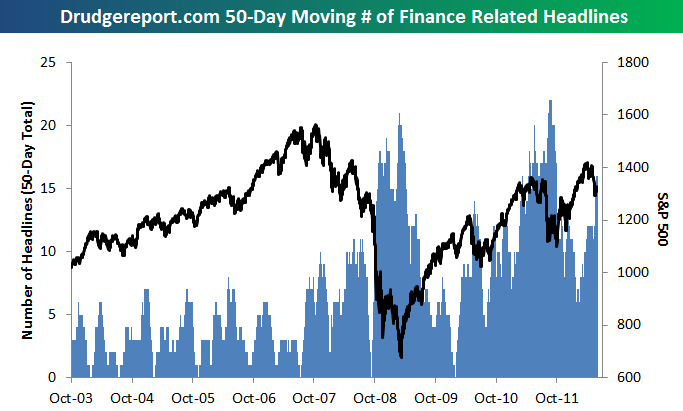The Drudge Report, with its 30,000,000 page views per day, is probably the most widely followed news source on the web. News junkies visit the site on a regular basis to get their daily link fix, while those in the media world — from the major networks and newspapers to independent bloggers — go to it multiple times a day. While political stories receive the majority of the site’s links, it’s whatever the site’s founder Matt Drudge believes to be the most important topic of the day that gets the main headline at the top of the page.
The Drudge Report is not a financial news site, so whenever a financial news story grabs the Drudge headline, it means that the story has crossed over from just a financial news story to a mainstream news story. And when a financial news story crosses over into the mainstream media, it means that those that don’t follow the market on a regular basis are suddenly following the market. This practically always occurs when the market (or economy, etc.) is going down and not up.
We track every Drudge headline at 9 AM, noon and 4 PM on daily basis going back to 2003 and tally the number of stories that were finance related using the Drudge Report’s massive archives service. We essentially wanted to see how often a financial news story was a front-page headline and not just a Money section headline. From a contrarian perspective, when financial stories dominate the front-page headlines on a regular basis, it’s probably getting close to an inflection point for the market, whether it’s a bottom or a top. (We counted any story that involved the economy or any asset class as a finance related headline.)
Below is a chart showing the number of days in which there was a finance related headline on Drudge over a rolling 50-day period since mid-2003. At our starting point, the market was in the early stages of the 2002-2007 bull market. Unsurprisingly, the number of finance related headlines hit a peak right around the time that the market made its financial crisis lows. The max reading of 21 days out of 50 with financial related headlines on Drudge came on February 27th, 2009, which was just 10 days before the S&P 500’s bear market low on March 9th. The number of financial headlines on Drudge then cratered all the way down to zero as the market and the economy recovered from the bear market, but then it started to pick up steadily once again in early 2010 as the crisis moved from our shores over to Europe.
During 2011’s version of the Euro Crisis, the Drudge Headline Indicator maxed out at a new record high of 22 in mid-August, breaking the high seen during the depths of the US financial crisis. This high also coincided with a major market bottom, and the major US indices went on to rally more than 20% from late 2011 through the end of the first quarter. Throughout the late ’11/early ’12 rally, financial headlines on Drudge once again waned. But since the second quarter began, headlines have quickly picked up. Over the last 50 days, Drudge has posted a financial-related headline on 16 days. But 12 of the 16 days that saw headlines have come over the last 25 days, so unless the market really picks up in the coming weeks, we’ll likely see a retest or even a new high in the Drudge Headline Indicator.
The fact that we’ve seen such a large amount of financial headlines in recent years on what is mostly a political website represents a key shift in society, in our opinion, stemming from the collapse we saw in 2008. Everyday citizens now pay more attention to the economy and the markets than they did before, and sentiment on the topic remains decidedly negative.
Click to enlarge:






